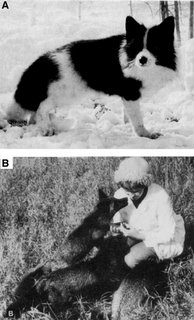

BEHAVIOR: DOMESTICATION OF THE FOX
In 1959, the Russian geneticist Dmitry K. Belyaev began studying the behavior of captive foxes at a fur farm. Interested in the process of domestication, he experimentally selected foxes on the basis of their reaction to humans. Individual foxes that responded with fear were removed from the experiment, while those without fear were retained.
Although Belyaev died in 1985, others have continued his experiment. Considerable variation has been noted, e.g., size, color, hair texture, floppy ears and curly tail. By the 6th generation, some foxes displayed behavior resembling domestic dogs — whimpering to attract attention and licking their keepers.
This domesticated behavior increased to 1 pup in 6 by the 10th generation, and to 3 pups in 4 by about the 30th generation. These changes have been accompanied by a reduction in secretion of adrenal hormones, a reduction in basal levels of blood plasma corticosteroids, and an increase in serotonin levels.
Other changes have occurred in morphology and reproductive behavior. In addition to foxes, the research group has also successfully domesticated river otters and Norway rats from wild-caught ancestors.
This experiment indicates that aggressive behavior has a genetic basis, and can be reduced rapidly through selection. This suggests that aggressive behavior might also become established rapidly if a world of peaceful coexistence became dominated by competition.

No comments:
Post a Comment